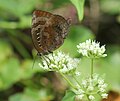
Languages spoken in the Republic of India belong to several language families, the major ones being the Indo-Aryan languages spoken by 78.05% of Indians and the Dravidian languages spoken by 19.64% of Indians; both families together are sometimes known as Indic languages. Languages spoken by the remaining 2.31% of the population belong to the Austroasiatic, Sino–Tibetan, Tai–Kadai, and a few other minor language families and isolates. According to the People's Linguistic Survey of India, India has the second highest number of languages (780), after Papua New Guinea (840). Ethnologue lists a lower number of 456.

Manipur is a state in northeast India, with the city of Imphal as its capital. It is bounded by the Indian states of Nagaland to the north, Mizoram to the south and Assam to the west. It also borders two regions of Myanmar, Sagaing Region to the east and Chin State to the south. The state covers an area of 22,327 km2 (8,621 sq mi). The official and most widely spoken language is the Meitei language. Native to the Meitei people, it is also used as a lingua franca by smaller communities, who speak a variety of other Tibeto-Burman languages. Manipur has been at the crossroads of Asian economic and cultural exchange for more than 2,500 years. This exchange connects the Indian subcontinent and Central Asia to Southeast Asia, East Asia, Siberia, regions in the Arctic, Micronesia and Polynesia enabling migration of people, cultures and religions.

Meitei also known as Manipuri, is a Tibeto-Burman language of northeast India. It is the official language and the lingua franca of Manipur and an additional official language in four districts of Assam. It is one of the constitutionally scheduled official languages of the Indian Republic. Meitei is the most widely-spoken Tibeto-Burman language of India and the third most widely spoken language of northeast India after Assamese and Bengali. There are 1.76 million Meitei native speakers in India according to the 2011 census, 1.52 million of whom are found in the state of Manipur, where they represent the majority of its population. There are smaller communities in neighbouring Indian states, such as Assam (168,000), Tripura (24,000), Nagaland (9,500), and elsewhere in the country (37,500). The language is also spoken by smaller groups in neighbouring Myanmar and Bangladesh.

The Cellular Jail, also known as 'Kālā Pānī', was a British colonial prison in the Andaman and Nicobar Islands. The prison was used by the colonial government of India for the purpose of exiling criminals and political prisoners. Many notable independence activists were imprisoned there during the struggle for India's independence. Today, the complex serves as a national memorial monument.

Mount Harriet National Park, officially renamed as Mount Manipur National Park, is a national park located in the Andaman and Nicobar Islands union territory of India. The park, established in 1969, covers about 4.62 km2 (18.00 mi2). Mount Manipur, which is a part of the park, is the third-highest peak in the Andaman and Nicobar archipelago next to Saddle Peak in North Andaman and Mount Thullier in Great Nicobar.
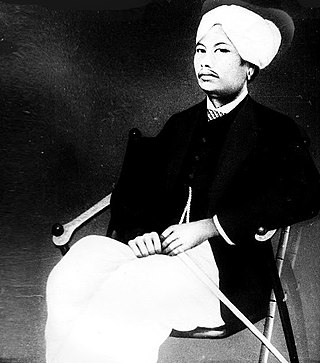
Tikendrajit Singh, also known as Koireng, was a crown prince of Kangleipak in present-day northeastern India, which was a protectorate of British Raj at that time. Tikendrajit was the commander of the Manipuri army and engineered a palace revolution that led to the events known as the Anglo-Manipur War of 1891 or the Manipur Expedition.
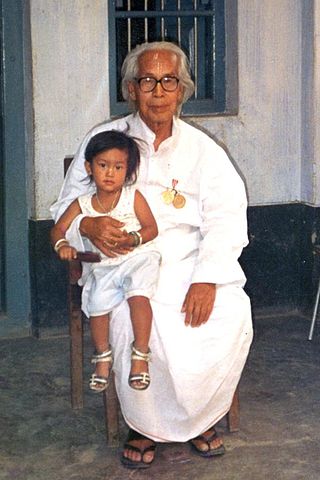
Padma Shri Ashangbam Minaketan Singh is regarded as one of the founders of modern Manipuri literature. He was born as the only child to Ashangbam Jivan Singh and Medhabati Devi on 2 May 1906. His grandfather Ashang Kut, also known as Ashangbam Phura Hongba, served as an Officer in The Maharaja of Manipur's army. In March 1891 he played a part in the assassination of British officials and was thereby sentenced for transportation on charge of murder. He was sentenced twenty five years of life imprisonment at Kalapani Jail, which is located in the Andaman and Nicobar Islands, India.

Kulachandra Singh was a Meitei monarch and the Maharaja of Manipur kingdom. He was a son of Maharaja Chandrakriti.

The Manipur Kingdom also known as Meckley was an ancient kingdom at the India–Burma frontier. Historically, Manipur was an independent kingdom ruled by a Meitei dynasty. But it was also invaded and ruled over by Burmese kingdom at various point of time. It became a protectorate of the British East India Company from 1824, and a princely state of British Raj in 1891. It bordered Assam Province in the west and British Burma in the east, and in the 20th century covered an area of 22,327 square kilometres and contained 467 villages. The capital of the state was Imphal.
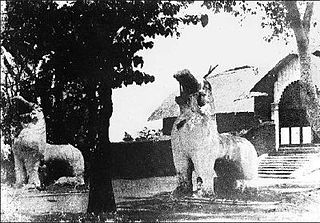
The Anglo-Manipur War or Manipuri Rebellion of 1891 was a short armed conflict between the British Colonial Forces and the dissenting royal princes of Manipur Kingdom, which was arguably a dependency of the British Empire in India. The conflict began with a palace coup staged by the general (Senapati) of Manipur, ousting its reigning king, and installing a half-brother, the heir-apparent, in his place. The British government took objection to the action and attempted to arrest the general. The effort failed, with the Manipuri forces attacking the British residency and the resident and other British officials getting executed. The British launched a punitive expedition that lasted from 31 March to 27 April 1891. The general and other rebels were arrested and convicted. The British conquered Manipur and did not annex it under British India but governed it as a princely state till 1947.
Manipur is a state in India.

The Cinema of Manipur is the film industry based in Manipur, India. It includes not only Meitei language movies but all the films made in different languages of the different communities in Manipur. The Manipuri film industry was born when Matamgi Manipur by Debkumar Bose was released on 9 April 1972. From Aribam Syam Sharma's Paokhum Ama, the first colour Manipuri film (1983), M.A Singh's Langlen Thadoi, the first full-length colour Manipuri film (1984) to Oken Amakcham's Lammei, the first Manipuri digital film (2002), Manipuri cinema, which celebrated its 50th anniversary in 2022, has grown in both its form and culture.
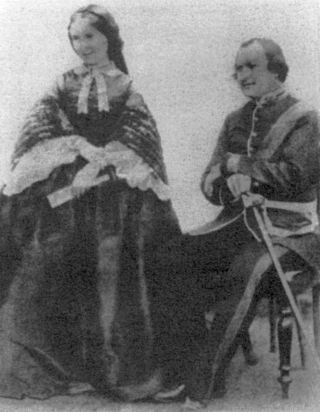
Harriet Christina Tytler was a British artist, writer, and a pioneer photographer. With her husband Robert Christopher Tytler, she created over 300 photographs. She is known for the documentation of monuments and the Siege of Delhi.
Lourembam Bino Devi is a practitioner and a popularizer of the appliqué art of Manipur called Leeba in the Meitei language. The Leeba art is used in creating Monmai which is a decorative circular appliqué art piece used in covering both ends of the traditional Manipuri bolster pillow. In the olden days, Leeba was practiced at "Phiribi Loishang", which is a house for maintaining clothes worn by the deities and royals. The apparels used by the royals, including shoes, were mostly designed using the Leeba technique. Bino Devi has devoted her life to practice this art form and to revive it by trying to transmit her skills to younger generation of interested women. She has been providing this training in collaboration with the Heritage Foundation of Mankind, a Non-Governmental Organization located in Imphal. She has also conducted several workshops at Imphal and at various other places in India.

Miss Manipur or Miss Manipur Queen is an annual beauty pageant that is run by the Manipur based Miss Manipur Committee (MMC). It is one of the most watched beauty pageants in North East India. It co-exists with Femina Miss India Manipur, Miss Kangleipak and Miss Meetei Chanu. The titleholder of Miss Manipur represents Manipur in the Miss North East, organised by Northeast Beauty Pageant Organisation (NEBPO) every year.

Pureiromba is a God in Meitei mythology and religion. He is the giver of rain and agricultural prosperity. He is one of the major Umang Lai deities. He is the Ancestor God of the Angom clan of the Meitei ethnicity.

Manipuri Language Day, is an annual celebration of the Manipuri (Meitei) language in India and Bangladesh on 20 August. It is the day in 1992 on which Manipuri was added to the Eighth Schedule to the Constitution of India, making it one of the official languages of India.

The social movement of Meitei language to be included as an associate official language of the Government of Assam is advocated by several literary, political, social associations and organisations as well as notable individual personalities of Northeast India.
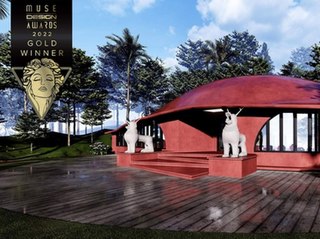
The Mount Manipur Memorial is a memorial site in the Mount Manipur of the Andaman and Nicobar Islands, India. Spanning over an area of more than 45000 sq ft, the memorial site is dedicated to the Manipuri freedom fighters and the martyrs of the Anglo-Manipur war. In the year 2022, the memorial site won the "International Muse Design Award 2022", through the designs of the "Huidrom Design Studios" from Manipur.
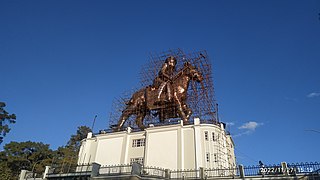
2023 in Meitei culture, including but not limited to Meitei architecture, Meitei cinema, Meitei cuisine, Meitei dances, Meitei festivals, Meitei language, Meitei literature, Meitei music, Meitei religion, Meitei script, etc.





